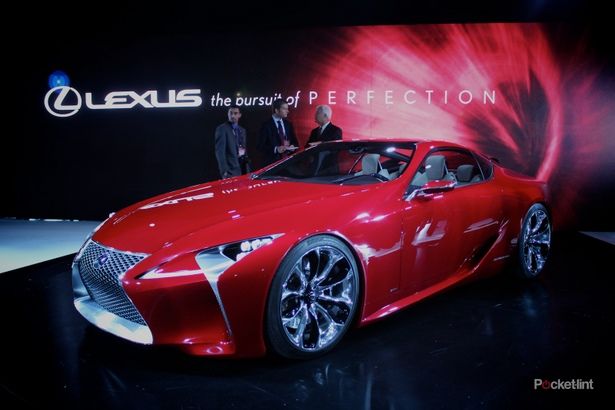There is one car's name on everybody's lips in Detroit: the Lexus LF-LC. This stunning, lipstick red super-sports car is sadly not bound for production anytime soon, but it does give us several clues to a Lexus-flavoured future. And we - along with about 10,000 motoring journalists, designers and auto industry execs - very much like what we see.
You'll no doubt be aware of Lexus' existing LF-A. The V10-powered supercar, of only a handful of which are being produced, cost a quarter of a million quid (or thereabouts) and sounds like rolling thunder. It's also the clearest signal we had that Lexus is serious about changing its image, and becoming a proper sports car maker.
So what's the LF-LC? While it's similar in size to the LF-A, it isn't intended as a replacement for that car. It's more a vision of what Lexus sports cars and coupés could be like in the future and what kind of design language they might have.

If anything like this does ever make production, we'll quickly have to rename what Alan Partridge famously called "The Japanese Mercedes" to something more akin to a Japanese Ferrari. Because everything about this car is "wild" and exotic – the proportions, stance, detailing - it's all extreme, but the result is that it looks like it's doing 100 mph while standing still.
Step inside and it gets even better. We've not been huge fans of Lexus interiors to date - they lack the class and material integrity of the German premium brands, or the flair of what some of the French - Citroen's DS brand for instance - are capable of. This however, is on a different planet. And while Leather, light brown suede, grey maple wood, aluminium and plastic might sound like a dogs dinner of a material palette, we suspect you'll agree that it looks awesome - and perhaps more importantly, deeply special.
That light brown suede door card wraps behind the back of the dashboard and then down into a centre tunnel. At its centre, behind a beautifully detailed steering wheel, sits a small gauge cluster that uses the same kind of Transparent-OLED technology we first saw in the Kia GT at the September Frankfurt auto show. It produces a hologram effect when the car's turned on, but in the Lexus it's embellished by some physical watch-like bezels that sit behind the glass, to give read outs for things like fuel and temperature.

To its right emerges a long, slim, tablet-like surface, where climate, infotainment and navigation controls are displayed. Rounding off the tech-fest, is a small device that's larger than a phone and smaller than a tablet, which sits at the front of the centre armrest and acts as an input device that falls easily to hand. We love the attention to detail and the whole tech strategy on display here - even the electric window controls are tiny, technological works of art.
Cars like the LF-LC might seem like the ultimate concept car tease. They're the kind of thing you're desperate just to jump in and drive off the stand, so it's frustrating that they're destined never to make production. But with the LF-A, Lexus showed its intent to compete with the best of the supercar big boys. The LF-LC suggests that the brand as a whole now plans to move up a gear, in terms of design, technology and driving performance. That's got to be a good thing, and if the next Lexus production cars can take even 20 per cent of the spirit of this concept into the showroom and onto the road, then Lexus has the ability to become a very exciting brand indeed.

